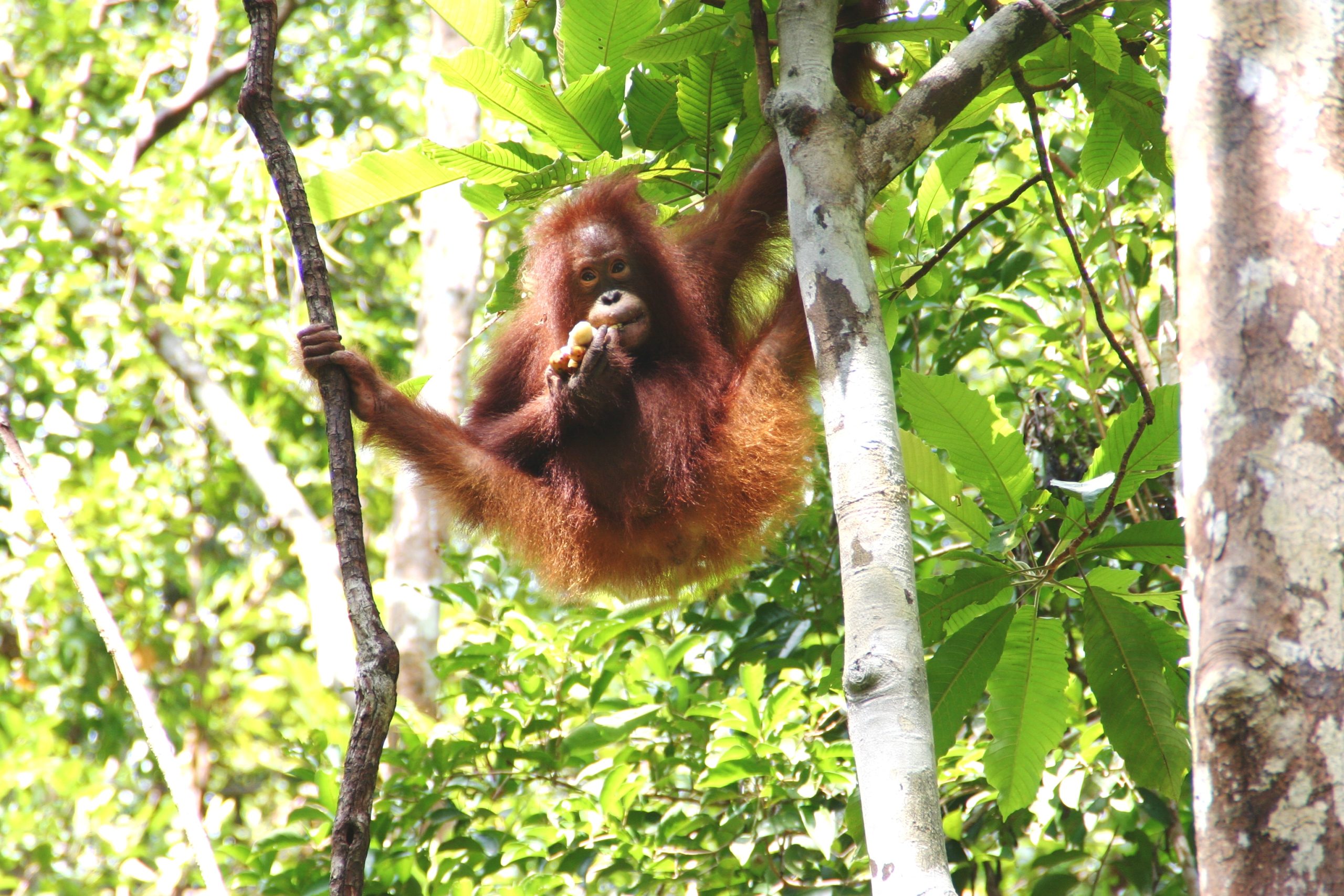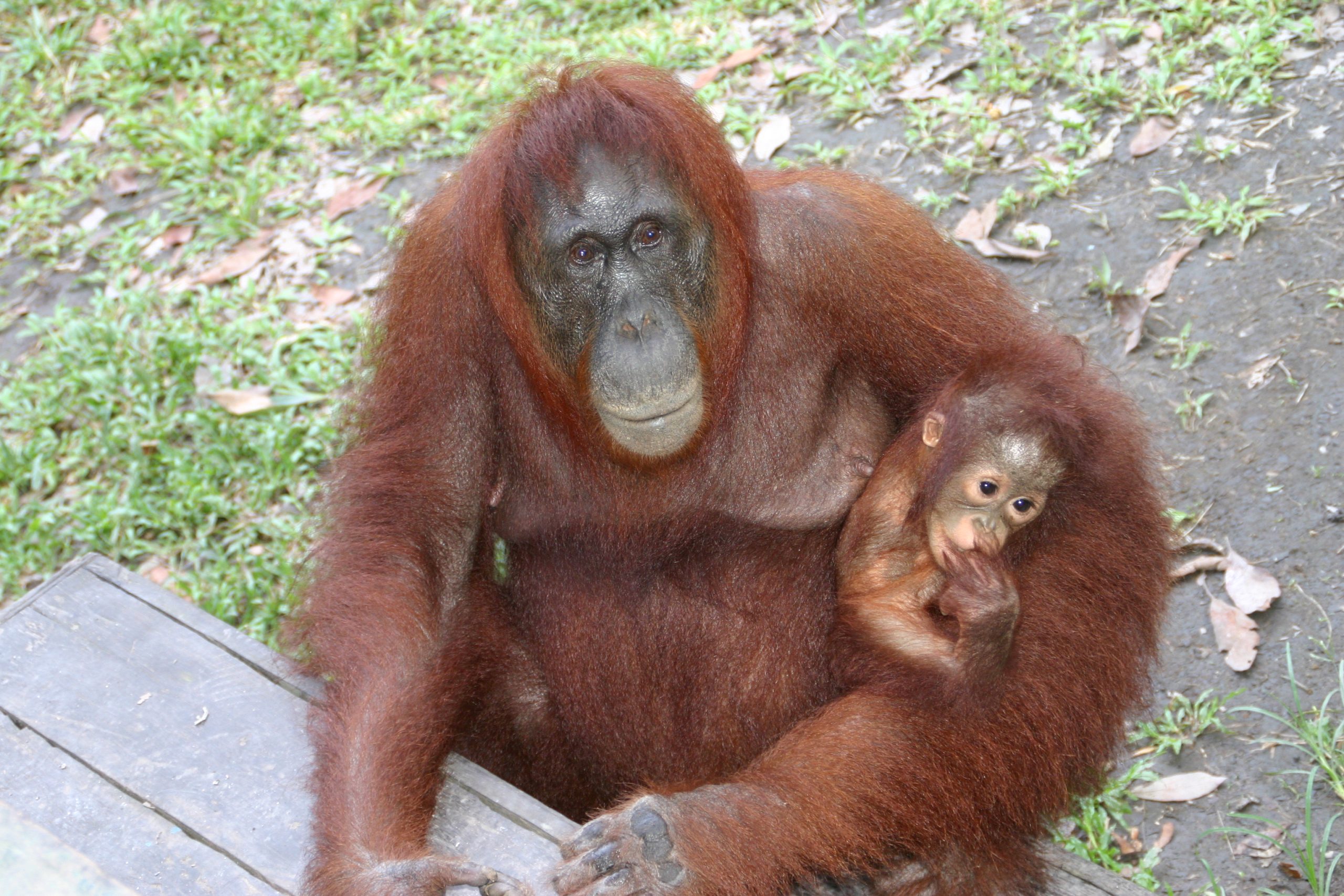David McNeill
Borneo~Homeless, semi-paralyzed and blind in one eye, Montana faces an uncertain future. Even if his friends find somewhere for him to live, the 15-year-old has been weakened by years in assisted care. The lethal dangers of readjustment in his natural home include men like those who shot him out of a tree when he was a baby. But for the source of the greatest threat to Montana’s existence, say his supporters, look no further than your food cupboard.
The orangutan, the largest tree-living mammal on the planet, is in crisis. Once a mighty orange army of 300,000 that swung through the dense forests of South East Asia, conservationists say the population has dwindled to fewer than 25,000 concentrated on the two Indonesian islands of Borneo and Sumatra. There, they cling precariously to existence on government-protected nature reserves under siege by developers of one of the world’s most lucrative commodities: palm oil.
Illegal logging, fires and clearances have decimated the tropical rainforest that is the exclusive home of the primates. A care centre near Pangkalan Bun in Central Borneo is crowded with over 320 homeless, orphaned and sick or injured orangutans, a number that grows by 20 percent a year, say the workers there. Montana peers unhappily from his cage; unlike 250 of his predecessors who have been relocated to the jungle upriver from here since this centre was set up in 1998, he is unlikely to ever leave.
“We just can’t find homes for all of them,” laments Birute Galdikas, the famed anthropologist who runs the care facility, after producing a long list of daily needs that includes nappies for the three dozen or so baby orangutans. “We are looking at the extinction of orangutans…in the wild.”
She estimates that without action, the primates – one of the four great apes along with gorillas, chimpanzees and bonobos, have perhaps 15 years left. The Borneo orangutan is listed as “highly endangered” by the International Conservation Union, one short stop on the ladder of extinction above its Sumatran cousin, which is critically endangered. “When it goes extinct, it will be a terrible loss,” says Dr. Galdikas. “I can’t tell you how urgent it is.”
To grasp how urgent, you have to travel from Pangkalan Bun up the chocolate-colored Sekonyer River to the heart of one of the world’s last great wildernesses, the Tanjung Putting Park, a 410,000-hectare nature reserve that is home to perhaps 6,000 orangutans along with proboscis monkeys, gibbons, macaques and crocodiles. The reserve is an oasis in a landscape pressured by the growing local population. Behind the thick canopy of mangroves and Pandanus along the Sekonyer, bald patches of cleared jungle can be seen from the boat. Guards posted along the river patrol for illegal logging and poaching: some orangutans are kept as pets or smuggled out of the country and sold to perform in Thai kickboxing matches or in circuses. But the “real issue”, say scientists, is palm oil plantations.
Actresses Julia Roberts and Joanna Lumley made this journey a few years ago, with documentary crews to film one of the only places in the world where orangutans can still be seen in the wild. Lumley is said to have been “horrified” to discover that her handbag was stuffed with cosmetics containing palm oil.
Extracted from the fast-growing oil palm tree, the commodity is now probably the world’s leading vegetable oil, surpassing its soybean alternative and used in a tenth of all supermarket products, including crisps, biscuits, toothpaste, margarine, detergents and cosmetics. 85 of percent comes from Malaysia and Indonesia – the world’s No. 1 and No. 2 producers respectively — often from giant mono-crop plantations hewn from the tropical forests and run by agri-business concerns with powerful political support.
“Greed drives the industry,” says Galdikas. “The industry is tied with the political elite who are making bundles of money off this. You have to see these mansions in Jakarta to understand the money that is coming from it.” She describes the clear-cutting of central Borneo for plantations as a “scorched earth” policy.
Conservationists say many of the devastating 1997/8 fires that robbed the orangutans of perhaps 30 percent of their habitat in Borneo and helped blanket much of South East Asian in a dense smog were caused by forest-clearing for palm oil plantations. Those fires briefly drew attention to the plight of the Borneo and Sumatra orangutan, but Indonesia is still furiously converting land and has announced plans to raze an area half the size of the Netherlands to make the world’s biggest palm oil plantation, according to the UK-based Orangutan Foundation.
About 4-5 million Indonesians now depend on the plantations to survive, says Greenpeace in Jakarta, and the number is surging. Over six million hectares of land across the country is already under palm-oil cultivation, and the figure is growing by 350,000 hectares a year, much of it in Borneo. A couple of years ago, say local forest guides here, 2 km was shaved off the northern end of the Tanjung Putting reserve. “Nothing is safe,” says one, who explains that the valuable forest hardwood, including teak and mahogany is often sold to finance the plantations.
The reserve is dotted with elevated feeding stations, where the guides leave ripened bananas and milk to supplement the animals’ diet. As a small group of tourists wait in the sweltering tropical heat, the animals descend from the forest roof, mothers hugging their children, accompanied by the sound of creaking and breaking branches. With their bulk and powerful grip, the orangutans do considerable damage to the trees, but they also help spread the seeds or new growth in the dung they leave across the forest, a process of regeneration that has gone on for millennia.
Then the dominant male arrives, a huge 250-lb bruiser dubbed Tom by the guides, who tell us that he is 24 and like all male orangutans, lives alone. “But we don’t know where, somewhere high in the trees.” As the forest shrinks around him, so do his sources of food, but the guides say they must not destroy the orangutans’ ability to forage, and turn them into parasites dependent on human charity. “The only way for them to survive is for us to preserve their habitat.”
The destruction of the rainforest here would also deprive many other animals of their home, including some not yet discovered. One estimate is that Indonesia is home to perhaps as many as 140 species threatened with extinction in the next few decades, including the Sumatran Tiger and the Asian rhinoceros. And in a bitter ironic twist, some may go the way of the dodo to meet demand for cleaner energy sources in a world choking on fossil fuels.
Cheap and carbon neutral, palm-oil diesel was until recently hailed as a safe, renewable alternative to petroleum, but such claims have been undermined by a series of recent studies. One by Wageningen University in Holland, published earlier this year, found that the carbon released from peat swamps in Indonesia and Malaysia, drained and burned to plant palm oil trees, released 2 billion tons of carbon dioxide a year into the atmosphere, or 8 percent of the world’s fossil fuel emissions.
“It is like kicking your head to get rid of a headache,” says Galdikas. “The palm oil prices are going through the roof because of their use as bio-fuel and this, one of the poorest countries in the world, is cutting down its trees to supply the market. It makes no sense.”
Scientists say the global warming caused by the release of this carbon is drying the forest floor, making it easier to burn and adding to the devastation caused by fires. To that double whammy — releasing vast quantities of carbon into the air while destroying the forests that suck it up – add another: the permanent, irreversible loss of countless animals. But demand for palm oil continues to rise. A $48 million palm-oil bio-diesel plant opened in Australia’s Northern Territories last year and three 50 megawatt power stations are planned in Holland. One of the plants, which will use 95-percent palm oil, has already been approved.
The Netherlands is Europe’s leading importer of palm oil, shipping 1.7 million tonnes last year, and the rest of the continent is not far behind: Europe aims to generate 10 percent of its energy needs from bio-fuels by 2020. According to Friends of the Earth in Holland, each bio-fuel refinery will gobble 80,000 tonnes of palm oil, or the harvest of a 20,000 hectare plantation per year; despite being one of the world’s most efficient energy crops, it takes a hectare of oil palm to produce about 6,000 liters of crude bio-diesel.
To help feed this demand Indonesia is boosting annual production of crude palm oil by about 10 percent, aiming to increase its current output of 16 million tonnes, explains Bustar Maitar of Greenpeace in Jakarta. “We don’t know how much yet but we suspect the bulk of this new output is going to bio-fuel plants abroad.” That means a lot more felled trees. “There are a lot of very bad things happening in the name of green policies,” says Anna VanSchaik of Friends of the Earth in Holland.
In the face of such criticism, Holland may have started to rethink its bio-diesel energy policies. Meanwhile, organizations such as the Malaysia-based Roundtable on Sustainable Palm Oil, which recommends tying imports to less environmentally damaging cultivation methods, have begun to have some impact. But environmentalists are divided. Can strict licensing and control of palm-oil use tame the free-market beast unleashed in the forests of Borneo, or is it better to simply scrap this once promising solution to fossil fuels and explore wind, solar and other options?
And will these efforts come soon enough for the orangutan?
The staff at the Pangkalan Bun care centre says each decision taken half way around the world brings the primate one step closer to extinction. Senior administrator Mrs. Waliyati fears more for her youngest charge, 9-month-old orphan Britney, than her oldest. “It might be too late for Montana, but what about the young ones,” she asks. The solution, she says, is simple. “Don’t use palm oil. If you do, it means you are agreeing to cutting down the rain forest. If you don’t stop, in 15 years, maybe sooner, there will be no place for these animals to live.”
The orangutan
One of our closest ancestors sharing 97 percent of the same DNA as humans, the gentle orangutan was once found across Indonesia and as far north as China, but is now on the edge of extinction. Earthwatch estimates they may have as little as 12 years left in the wild, after which our only chance to see them will be in zoos, where about 1,000 are kept in captivity around the world. Their name comes from the Borneo word “Orang Hutan,” meaning “People of the Forest.”
Almost totally dependent on trees, the animals survive on a mostly fruit-based diet supplemented by bark, flowers, leaves and insects. They mostly live and forage alone, except when mothers are nurturing their children and teaching them how to survive in the dense forests, a process that takes up to six years. Scientists believe the animals are equipped with large memories to help them locate the thousands of food sources on which they depend.
Extremely slow to breed, the inter-birth cycle in orangutans takes up to eight years, limiting females to three or four offspring in their 45-year lifetime. Although successfully bred in captivity in Australia and elsewhere, the long-term impact of captivity on the species is not known, but is likely to be negative. Scientists say it is better to save them now. “Concern for orangutans indicates concern for the planet,” says Birute Galdikas.
This is a much expanded version of an article that appeared in the London Independent newspaper on September 4, 2007. David McNeill writes regularly for a number of publications including the Irish Times and the Chronicle of Higher Education. He is a Japan Focus coordinator. Article and photographs by David McNeill. Posted at Japan Focus on September 19, 2007.









